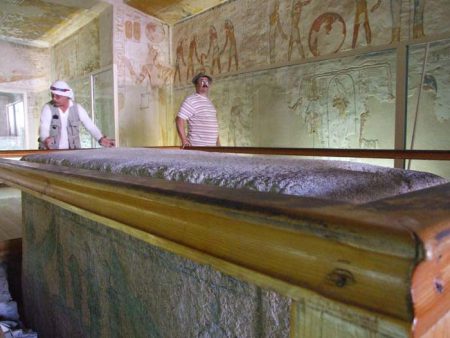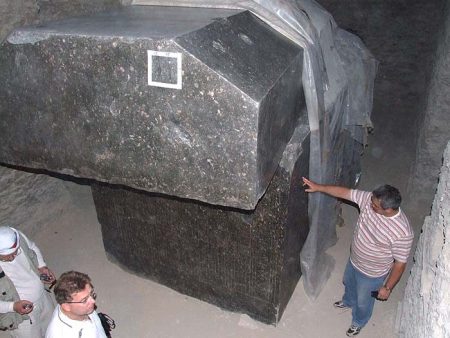|
Publications ONWARD TO THE PAST
At first about pyramids. Following features of pyramids are known: Mathematical – in correlations of their geometrical elements are put "golden section" (correlation between an apothem of the lateral side and half of length of the Cheops pyramid basis ) a number «pi» (the basis perimeter is equal to length of the circle which radius is equal to height of Cheops pyramid ) and trigonometrically features, probably, the following from the used constructions (the tangent of inclination angle of the lateral side of Cheops pyramid is equal to the return sine of this angle(51 degree and 30 minutes)).. Astronomical – the orientation of the pyramids on a line the north-south is executed with precision within 3 minutes of arch; there are channels focused to some stars. Geological – except the local material (limestone of the rocks located in several hundreds meters) were used granite (presumably brought from Aswan which is in 900 km above along the Nile current ) and basalt (the origin is not known). Technological – during the building millions blocks of limestone with average weight of 2,5 tons were used, plates in weight more than 200 tons careful trimming not only calcareous but also granite and basalt plates was repeatedly used; there are drilled in the granite and basalt conic apertures and cores corresponding to them (are found in the end of 19th century) with a groove with 2 mm. step ; the channels laid in thickness of the pyramids are executed along the lines deviating from the straight line not more than 5 mm in distance of order 80 m, planes of pyramids sides are executed with the big accuracy. Questions consist in the following: - being rather impressing constructions they possess with all features which do not correspond to representations about the development level of those times civilization . - neither function of the pyramids, nor function of premises and channels (taking into account their arrangement and the sizes), available in pyramids is not clearly. - despite of the great volume of ancient Egypt cultural heritage it is revealed neither descriptions nor the drawings connected with building of the pyramids together with their images. Everything that is known - the hieroglyph of "measures" designating the pyramid. The Russian researchers consider that ancient Egyptians did not build pyramids but only used constructions existing before them. MIRACLE WHICH WAS IN USE What is the pracivilization? Plates from the black basalt used at building of some Egyptian pyramids and temples have preserved traces of the disk saw which ancient Egyptians with their level of technological development (as it is standard to consider) could not be in no way. And what about apertures in granite? What augers and drills were applied in the time of Pharaohs? Pyramids themselves , probably, stand on the place of more ancient semi underground constructions with not clear functions: either shelters from natural cataclysms or refuges on case of wars. Whether the version is possible that the Egyptian state has arisen on the basis of any early civilization . In the beginning of III century BC in Egypt llived historian Manetho. In our time he is known, as the only one ancient Egyptian author who has made high-grade historical work on stories of Ancient Egypt - the author of the book ««History of Egypt» » Manetho has left to us the chronological list of Egypt governors including the first kingdom when gods governed with the country 10-12 thousand years ago. Probably, it concerns the representatives of unknown to history an ancient civilization (some researchers consider that it concerns Atlantis)
It is remarkable that one and half centuries ago in the Egyptian Giza was found, so-called, inventory stela , on which it is specified that Pharaoh Cheops ordered to repair the damaged statue of the Sphinx (under the standard version, it is built nearby 2,5 thousand years B.C.). Traces of rain erosion have remained on it . But it is known that Egypt exists without pouring rains not less than eight thousand years. When somebody paid attention to it the Egyptian authorities which frightened something they ordered to remove the inventory stela in a storeroom of the Cairo museum and the Sphinx surface they decided to restore urgently. Did they decide to clean traces of erosion ? What do they hide? If you are lucky however to get to Aswan stone quarries,pay attention to bore pits going some meters into deepness. In diameter they are about semi-meter and there are a lot of them there. It is interesting the person, standing on his head hollows granite to some meters downwards polishing channel walls. And is it all for what? According to Egyptologists so that to look the direction of crack which, by the way, is perfectly defined and from outside. The conclusion can be made one ancient people had the tool allowing to work with granite as with polyfoam. Two more curious facts. Pyramid of Cheops. In its basis the rock lies in height about 10 meters but the basis of this granite surface from a horizontal is 2 cm with the side of almost ideal square in 230 meters. Throw out of the sides makes no more than 10 the sm. The pyramid also is almost ideally focused to the sides of the world. An error of positioning is 0,015 %. I work in the field of building. Even in our time having all laser devices it is almost impossible to achieve such accuracy . What devices did the builders of pyramids use? One more important detail was that the surface of pyramids was covered with the polished limestone bent in the centre. This covering was so shining that its reflected light could be seen from the Moon. By the way, the radius of the surfaces bend repeated radius of the bend of the Earth surface and, therefore, was not visible close by. Later, earthquake loosened facing and Arabs took away these stones for restoration of Sultan Hassan mosque , Cairo palaces and the rest. Stones with which the pyramid was rewetted are joined with the interval 0,5 mm with ideal right angles. And this proximity was intended for filling with glue doing them water-proof. Besides, by my personal experience in building, even today when the facing tile is made in workshops by means of machines, ideally equal plates with angles exactly in 90 degrees it is impossible to prepare . We buy plates in Spain and Italy, because these plates are with the least error. And they are ideal at Egyptians . How is it? There is also one more to my opinion the important moment. Dating of the pyramids is found out by the radiocarbon dating. And it is capable to define age only organic substances. That is the age of the pyramids was defined on the rests of the wood left the ancient. For example the Sphinx was constructed at the time of Pharaoh Cheops 2500 B.C. But it is not the fact that exactly they were builders. 150 years ago in Giza was found so-called «Inventory stela» about which I wrote above on which was wrote that Cheops only ordered to "restore" the Sphinx, but does construct it. Moreover, there is a theory that the Sphinx was so terrible that people could die of fear, only having looked into its eyes. And, therefore his face altered in more human one. Also, it was proved in the nineties that furrows on the Sphinx body are traces of rain erosion. But, as I already marked rains in Egypt were not already more than 8 thousand years. But the Sphinx is much later than pyramids construction. On the pyramids of 6th dynasty blocks were 500 kg each. On the pyramids of 4th dynasty blocks were from 2 to 50 tons. The limestone density is 2,63 - 2,73 g/sm3. I was at the pyramids and saw blocks in the size 1,5х1,5х2м. If to count their weight is more than 12 tons. I will allocate you means so that you employed ad lib(itum) people that they without support of mechanisms would lift this block in height at least twenty five meters and put it there « joint in joint» with another one. The pyramid according to Herodotus was under construction 20 years. If to count all blocks used in construction and there are of them 2,3 million that calculating we receive that these workers put against each other 315 blocks in a day with average weight in 5 tons everyone. It approximately 13 blocks in a hour . And it is about 4,5 blocks in a minute. It is mathematics. What were the workers? Here is one more riddle. How could workers move and process so massive stones? If to investigate the stones which are situated on perimeter of Cheops pyramid it is possible to find stones with slits as from a disk saw. And at that during saw cut there is also grinding. This effect can be achieved only with the diamond dusting disk rotating with the great speed. But ancient Egyptians worked with copper saws which cannot simply make anything similar.
Also traces from cutting of disk saw it is possible to find in stone quarries in Southern Sakkara , пbut they do not let go tourists there. Why do not let go?
However, if to get accustomed to the ancient Egyptian artifacts it becomes clear that drilling of apertures in stones even the firmest rocks did not make for Egyptians of any serious problem. On the next photos you see the channels made presumably with the method of tubular drilling.
In the majority of granite doorways in the temple of the Valley located near Sphinx channels from the tubular drill are well appreciable. During the building of the temple apertures were used, probably, for fastening of the door loops at hanging of doors. On the next pictures you can see something more impressing the channel in diameter approximately 18 cm, obtained in granite with help of tubular drill. The thickness of the cutting edge of the tool amazes. It is improbably that it was copper at an available thickness of butt wall of the tubular drill and prospective effort having on its working edge, it should be the alloy of improbable durability (on the picture one of the channels, opened at split of the granite block in Carnac is shown)
Probably, purely theoretically, in presence of apertures of this kind there is no something exorbitant improbable that could not be obtained by ancient Egyptians at huge desire. However, drilling of apertures in granite is rather difficult work. . Tubular drilling is specialized enough method which will not develop without real necessity to have apertures of big diameter in firm rocks. These apertures show the high technological level developed by Egyptians, probably, not for «hanging of doors», but already the level which was quite developed and advanced by that time and which would demanded at least several centuries for the development and preliminary experience of application. Some arguments of "concrete pyramids» version supporters. Hypothesis about concrete used during building of the pyramids, for the first time put forward in the late seventies French (or Swiss, the information disperses) scientists. Various experts were engaged in check of their concept. Using X-rays, electronic microscopes and plasma burner they have found traces of " fast chemical reaction preventing to the natural crystallization». For natural stones such phenomenon is inexplicable but he confirms artificial origin of limy blocks. The Frenchman in his turn has successfully tested manufacturing of concrete constructions from limestone: in the Institute of geopolymers in Sen-Kventine he managed to make and dry out for ten days a big block on hypothetical Egyptian technology. But opponents of Frenchman theory, those experts, assert that for concrete manufacturing to ancient Egyptians huge quantities of chalk and coal required. Chalk and coal remains near to the pyramids were not found. Besides, there are no evidence of forms use for casting of blocks. Probably and concrete plates but traces in any way are. Whichever way you look at it whether it be the technology of "granite" concrete or mill Egyptians were not so simple as official history describes them. And then the fact that Egyptians used concrete does not mean that pyramids are entirely constructed of it. «Technology applied (but not everywhere) at the top levels of constructions» but on the bottom ones there are the same blocks from limestone. Cannot geologists really distinguish limestone from concrete? Many consider that Egyptians only restored pyramids, and they have been constructed to them, here then «calcareous concrete» could be applied. Let us make the small result on the given above arguments : 1. There are two types of pyramids on Giza plateau ones (pyramids of Cheops, Chephren, Mikerin, etc.) are made of granite and limestone large-size blocks (2,5-70 tons) and reach the enormous sizes; others "small" pyramids in tens times less of the first ones and as material for them served small blocks of limestone (hardness is lower than granite) or in general they were made of clay bricks. And the first ones were erected (as historians think ) during a very short period, in times of the Fourth dynasty (75 % of all pyramids volume ) whereas the second ones were constructed later and turned already into ruin. A question: Do Egyptians lose all skills of building for some centuries? In terms of these facts there are some assumptions: 1. The Egyptian civilisation has come from without when many pyramids were already constructed. Egyptians only restored pyramids. «God will replace you with other people which will not resemble you!» (The Koran, 47:38) The questions can appear «Where did these tools disappear? Really, did not remain anything from civilizations except pyramids?». More suitable question would be «Where did the machineries rotating these tools disappear. Concerning their absence there are some assumptions: First, the size we will admit drills even big is non-comparable with the size of the pyramid and to search for it is impossible as a needle in a haystack. Secondly, under pyramids and under all Giza plateau there is a network of subways and caves where the foot of the person did not go yet. The third, about the age of the pyramids is not known till now precisely but it can be very considerable. Since their building could be numbers of cataclysms, including the bible flood or tsunami which could simply wash away all evidence of someone existence and destroy some pyramids. The fourth, it is not necessarily if there were drills or mills probably that other technologies unknown to us were used. But certificates of these technologies of application there are a lot , enough certificates in Cairo museum. Here are only some of them.
Why did Egyptians degrade? It is clearly to any who visits area of the pyramids, that after the Fourth Dynasty there was a sharp decline in business of their construction. Pharaohs of the Fifth Dynasty have erected rather small five pyramids in Abuser approximately in nine kilometers from Giza and two small pyramids in Sakkara, nearby to the step pyramid of Joser . All of them were built artlessly enough and their internal part has fallen what is absent in the pyramids of the Fourth dynasty previous to it. All pyramids of the Fifth dynasty now are simply the heaps of stone blocks . In times of the Sixth dynasty in Sakkara four small pyramids all approximately in 53 meters in height were erected but they have now even more pitiable appearance. On it actually "epoch" also has ended. Late pyramids. 6 dynasty.
Early pyramids. 4 dynasty
Obvious difference of one pyramids from others can indicate to that the early pyramids were constructed not by the same who built the late. Here are some more curious photos:
It is visible on photos that facing blocks were leveled after packing. Plus the surface of raw blocks is not similar to that one which extract in the stone quarry it is smoothed.
Some more about the Egyptian pyramids
WHERE DID THE SKILL OF PYRAMIDS BUILDERS DISAPPEAR? Tomb of Seti II (or Sethos II). The sarcophagus is for some reason turned up the bottom and put over a small hole even without closing it completely. With all its parametres it literally shows real possibilities of Egyptians of the period already even the New Kingdom in processing of firm rocks. Though they tried for Pharaoh but above the head could not jump.
By materials of: Adinah.wordpress.com |
|||||||||||||||||||

 Everybody know about the Egyptian pyramids. And everyone is familiar with the official version of their origin: pyramids are constructed with exploitation of thousand slaves. But, always were skeptics who subjected this version to doubt. In that sense illiterate slaves could not construct so grandiose objects. Then who then? When there is no convincing hypotheses imagination comes. As authors of pyramids considered inhabitants of Atlantis or aliens. But many people having heard about these versions preferred to trust in slaves and Pharaohs further . But questions remained.
Everybody know about the Egyptian pyramids. And everyone is familiar with the official version of their origin: pyramids are constructed with exploitation of thousand slaves. But, always were skeptics who subjected this version to doubt. In that sense illiterate slaves could not construct so grandiose objects. Then who then? When there is no convincing hypotheses imagination comes. As authors of pyramids considered inhabitants of Atlantis or aliens. But many people having heard about these versions preferred to trust in slaves and Pharaohs further . But questions remained. 
 Also, not far from the place where guides lead of tourists –
Also, not far from the place where guides lead of tourists –  ОPay attention. Traces of saw cut on basalt are accurate and parallel. Quality of this work testifies that slits were made with ideally steady blade without any signs of initial lateral movement of the blade. Such sensation that the basalt cutting in ancient Egypt was not so labour-intensive business because masters with ease dared to leave superfluous, "preliminary " traces on the rock which under condition of manual saw cut would be superfluous expenditure of time and forces. Such "preliminary " saw cuts are not unique here, some similar traces from the steady and easily cutting tool can be find in radius of 10 meters from this place. Along with the horizontal there are also vertical parallel furrows.
ОPay attention. Traces of saw cut on basalt are accurate and parallel. Quality of this work testifies that slits were made with ideally steady blade without any signs of initial lateral movement of the blade. Such sensation that the basalt cutting in ancient Egypt was not so labour-intensive business because masters with ease dared to leave superfluous, "preliminary " traces on the rock which under condition of manual saw cut would be superfluous expenditure of time and forces. Such "preliminary " saw cuts are not unique here, some similar traces from the steady and easily cutting tool can be find in radius of 10 meters from this place. Along with the horizontal there are also vertical parallel furrows. One more interesting detail - use in ancient Egypt of such technology as drilling. The drilled channels in various products of Ancient Egypt vary in limits from 0,63 cm to 45 cm in diameter. The smallest aperture made in granite, is about 5 cm in diameter. The granite product shown on a photo drilled with tubular drill was exposed in Cairo museum without any accompanying information and the guides themselves did not possess with any information. On the photo circular spiral grooves on the open sections of the the product absolutely identical each other are well visible. Characteristic "rotary" drawing of these channels, apparently, confirms supervision about the method of granite part removal with preliminary drilling of original "chain" of apertures.
One more interesting detail - use in ancient Egypt of such technology as drilling. The drilled channels in various products of Ancient Egypt vary in limits from 0,63 cm to 45 cm in diameter. The smallest aperture made in granite, is about 5 cm in diameter. The granite product shown on a photo drilled with tubular drill was exposed in Cairo museum without any accompanying information and the guides themselves did not possess with any information. On the photo circular spiral grooves on the open sections of the the product absolutely identical each other are well visible. Characteristic "rotary" drawing of these channels, apparently, confirms supervision about the method of granite part removal with preliminary drilling of original "chain" of apertures.




 The bottom part of this granite vase is processed with such accuracy that all vase (approximately 23 cm in diameter, hollow inside and with a narrow throat), being is put on the glass surface accepts after rocking absolutely vertical position along the axial line. But the area of contact with the glass of its surface is not more than area of egg contact . A necessary condition for so exact balancing – is that the hollow stone sphere should have ideally equal, identical thickness of walls (at so tiny area of the basis - less than 3,8 мм2 - any skewness in such dense material as granite would lead to the deviation of the vase from the vertical axis)..
The bottom part of this granite vase is processed with such accuracy that all vase (approximately 23 cm in diameter, hollow inside and with a narrow throat), being is put on the glass surface accepts after rocking absolutely vertical position along the axial line. But the area of contact with the glass of its surface is not more than area of egg contact . A necessary condition for so exact balancing – is that the hollow stone sphere should have ideally equal, identical thickness of walls (at so tiny area of the basis - less than 3,8 мм2 - any skewness in such dense material as granite would lead to the deviation of the vase from the vertical axis)..
 Also in Cairo museum is exposed large enough (60 cm in diameter or more) the original product from flaky slate. It reminds the big vase with the cylindrical centre of 5-7 cm in diameter with external thin rim and three plates located in regular intervals on perimeter and bent to the centre. What is it and how could it be used is not indicate. Guides do not possess the information. In the museum there is the whole hall with such not clear products.
Also in Cairo museum is exposed large enough (60 cm in diameter or more) the original product from flaky slate. It reminds the big vase with the cylindrical centre of 5-7 cm in diameter with external thin rim and three plates located in regular intervals on perimeter and bent to the centre. What is it and how could it be used is not indicate. Guides do not possess the information. In the museum there is the whole hall with such not clear products.
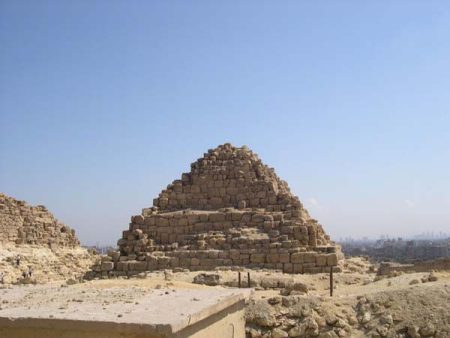
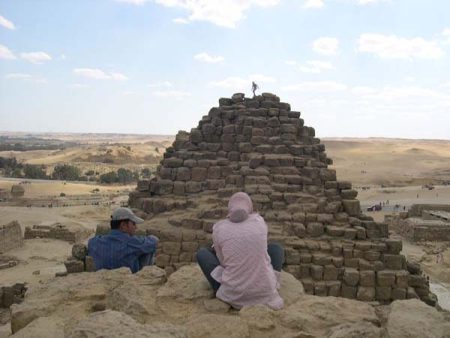
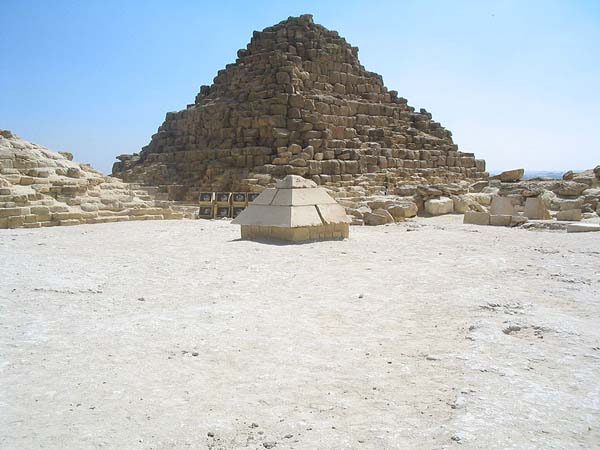
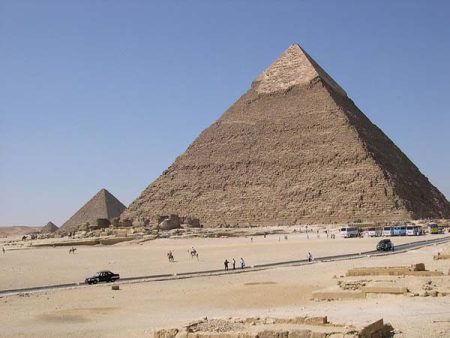
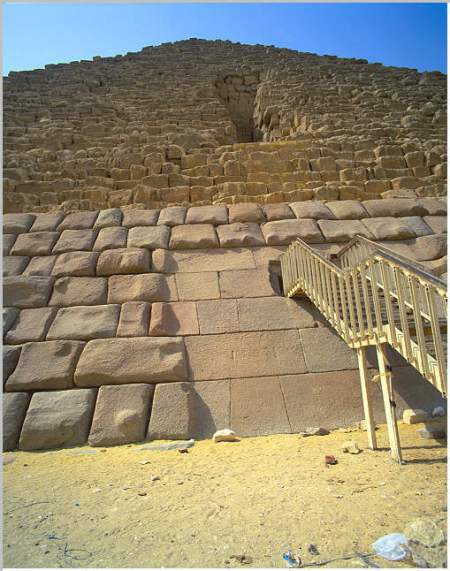
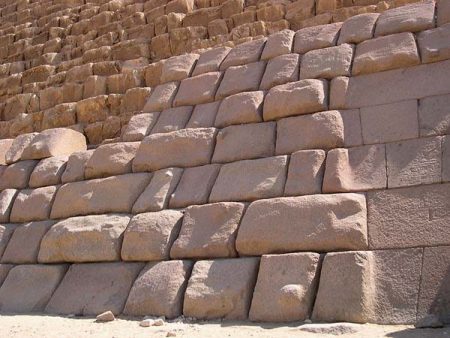
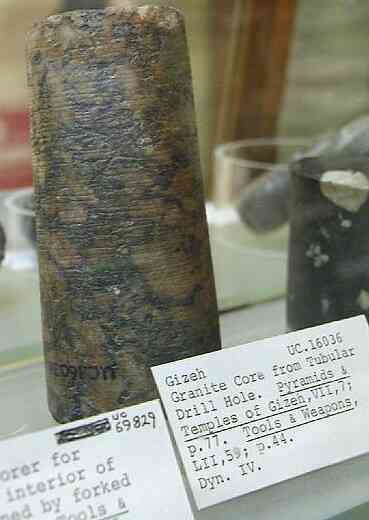
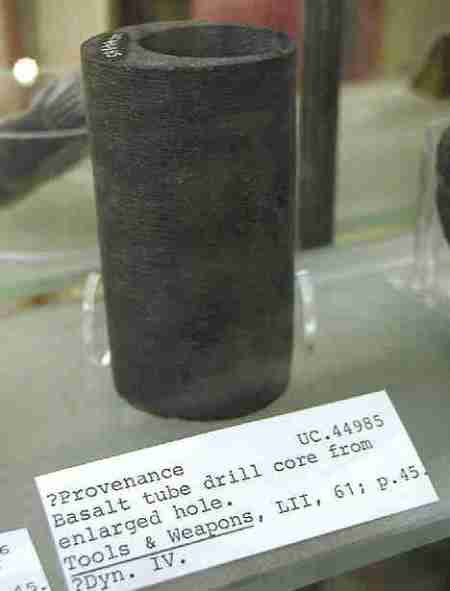
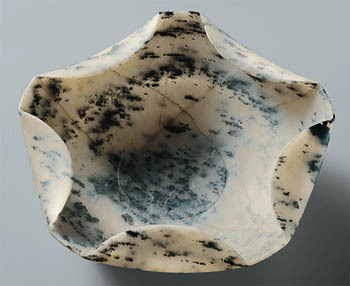 Plate or crucible with the bent edges from gneiss (almost granite). A thickness of the wall is 2 mm. As for me, it is improbable that it was turned to such kind. It is more similar that edges are bent. About mission, it is most likely it used for fusion of reagents.
Plate or crucible with the bent edges from gneiss (almost granite). A thickness of the wall is 2 mm. As for me, it is improbable that it was turned to such kind. It is more similar that edges are bent. About mission, it is most likely it used for fusion of reagents.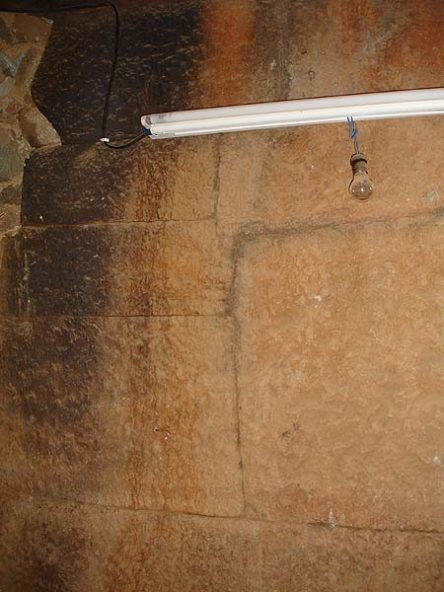 Some pyramids of different dynasties are constructed of not burnt bricks and badly processed stones put on the solution and on the bottom levels they have a high-quality laying from megalithic blocks. These two absolutely different technologies applied in one place allow to judge that these pyramids were constructed on ruins of more ancient constructions.
Some pyramids of different dynasties are constructed of not burnt bricks and badly processed stones put on the solution and on the bottom levels they have a high-quality laying from megalithic blocks. These two absolutely different technologies applied in one place allow to judge that these pyramids were constructed on ruins of more ancient constructions.
